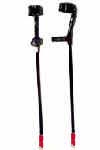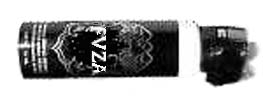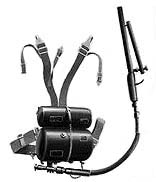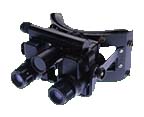In over 100 years of fighting vampires and zombies, the FVZA evolved from a motley assortment of ill-equipped soldiers to a sophisticated fighting force with all the latest technology at its disposal. The Agency's tireless quest for better ways to combat the undead resulted in technological innovations, like night vision, which proved to be of great use long after the FVZA was gone. An FVZA soldier's arsenal generally consisted of two types of weapons: those for protection, and those for killing.
PROTECTION
Advance teams probing for vampire packs were limited in the amount of firepower they could deploy. Regular bullets were not effective against vampires and could be dangerous in confined, dark spaces. In an emergency situation, an overwhelmed soldier would call upon a variety of repellents to drive off attackers. Early repellents were often crude and homemade and reflected the prevailing superstitions of the times: soldiers would smear garlic on their necks and wrists and drape crosses over their necks. But voracious vampires quickly proved the folly of these repellents, and more powerful means became necessary.
 |
| O'Malleys |
One of the first great vampire-fighting inventions of the 20th century was discovered almost by accident. On a chilly fall night in 1912, a Minnesota farmer named Willis O'Malley was awakened by a great commotion from the animals in the barn. Thinking a fox had slipped into the chicken coop, O'Malley grabbed a shotgun and went to investigate. When he entered the barn, he was set upon by two vampires. O'Malley blasted away at the intruders, but to no avail; they tossed his gun aside and prepared to sink their teeth into him. Desperate, O'Malley grabbed the only thing he could reach: a cattle prod. The implement worked like a charm, and the vampires disappeared into the night, hissing fiercely. Thinking he might be on to something, O'Malley spent the next day in his workshop, where he modified two prods, adding leather arm-straps and jerry-rigging a button to be operated by the user's thumbs. Within a year, "O'Malleys" were being mass-produced for vampire fighters all over the world. These prods allowed soldiers to drive off attacks from all sides. FVZA soldiers who employed O'Malleys were known as "buzzers" and received highly-specialized martial arts training.
 |
| The Wavemaker |
Repellents generally exploited the fact that vampires have heightened senses of smell, sight and hearing: bright lights, powerful odors and loud noises can drive them off. In 1954, FVZA researcher Tom DiStefano discovered that ultrasonic sound waves, inaudible to normal human beings, could create extreme discomfort in vampires. The discovery led to the invention of portable devices that could be quickly and easily deployed. The most popular of these, the "Wavemaker," was made available to the general public and helped save quite a few lives in the late '50s and early '60s.
 |
| High-Concentration Mace |
Like Wavemakers, mace and pepper spray were also easily portable and served as a last resort in close, hand-to-hand combat. Unfortunately, all repellents, no matter how powerful, proved to have a limited shelf life. Vampires are supremely adaptive creatures, and so older and more experienced individuals quickly developed countermeasures against repellents. Inevitably, vampires had to be destroyed, and a host of sophisticated weapons were developed for that purpose.
KILLERS
 |
| Flamethrower |
There have always been two reliable ways to kill vampires and zombies: decapitation and incineration. And so FVZA weaponry reflected these choices.
Flamethrowers were merely the latest, most efficient example of a long tradition in vampire fighting. In the Middle Ages, mobs armed with torches often trapped vampires in buildings before burning them down. The flamethrower first came into use early in the 20th century. Early flamethrowers were hopelessly bulky and required two men to operate. But the close-quarters combat of World War II necessitated more portable flamethrowers, and when the war ended these machines were put to good use by the FVZA. Each FVZA platoon had at least one specialist, known as a "fireman;" and once the advance team had confirmed the presence of vampires, the fireman would lead in the extermination team to finish the job.
 |
Migraine Molly
(enlarged cross-section) &
Night Stalker |
A turning point in the war on vampires came with the invention of the explosive bullet. FVZA firearms specialist Don Cassidy called his creation the Migraine Molly, after his wife. Coupled with the Ruger "Night Stalker," a high-powered pistol with a night-vision scope, the bullet greatly increased the safety of FVZA operations and was responsible for the majority of vampire kills from 1950 to 1975. After the FVZA was disbanded, these weapons found their way into inner-city gang wars, with catastrophic results.
 |
| Night-Vision Goggles |
Of course, all the explosive bullets in the world would have been useless without another important innovation: night vision. Night-vision goggles first appeared in the years after World War II and grew more sensitive and portable through the 1960s. Night-vision goggles allowed for safer extermination operations in the dark quarters (basements, caves, etc.) that vampires called home.
CAPTURE
 |
| Vampire Snare |
Occasionally, it became necessary to capture vampires for research and study. Capture operations were always done in the daylight and typically began by flushing the vampires from their base with tear gas. Once in the daylight, the disoriented vampires were surrounded and restrained with long-handled snares similar to those used by dogcatchers. Armed FVZA staff stood by in case of escape.
Return to FVZA Hub
© 2001-2015 Dango Productions, Inc.










